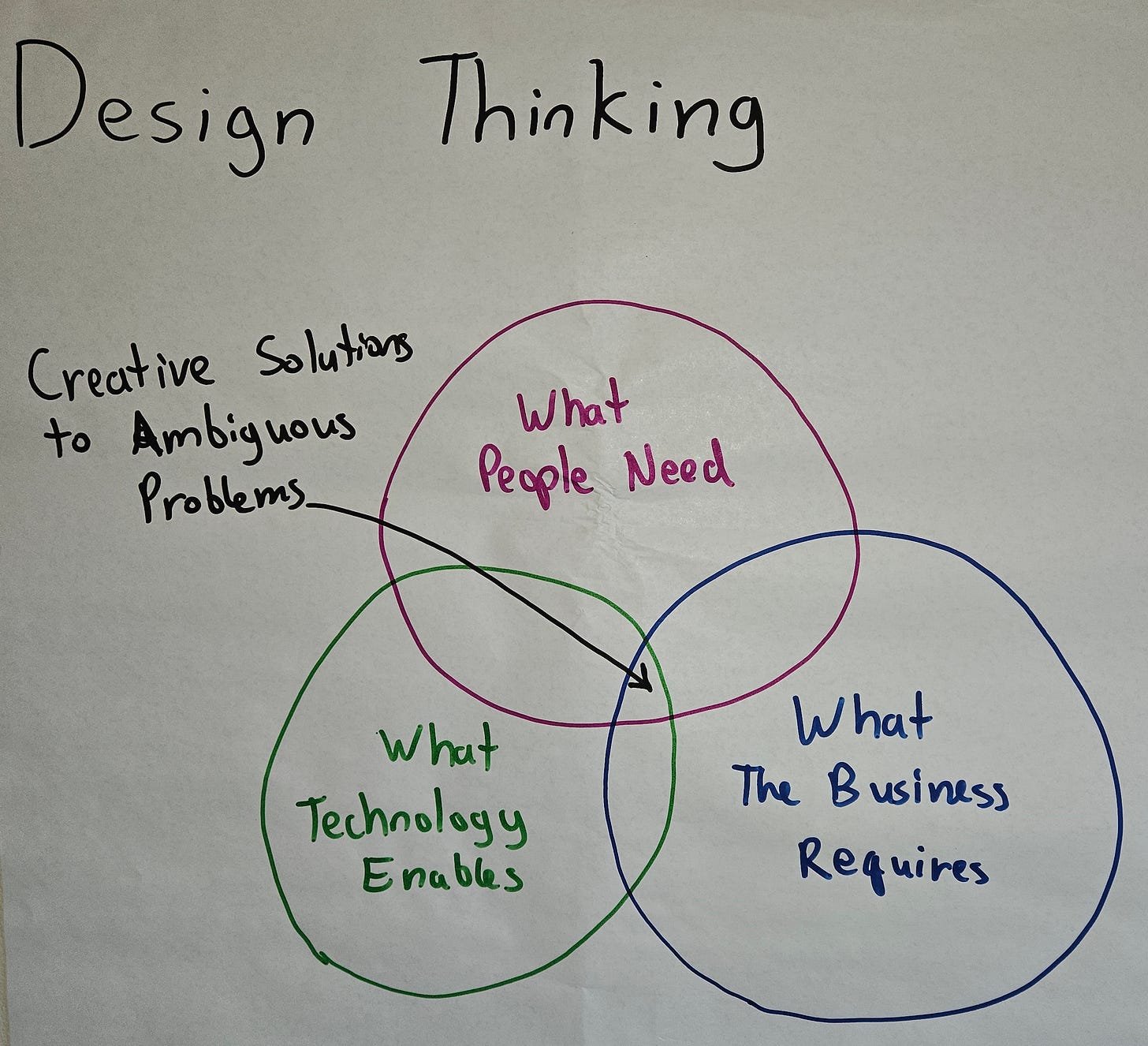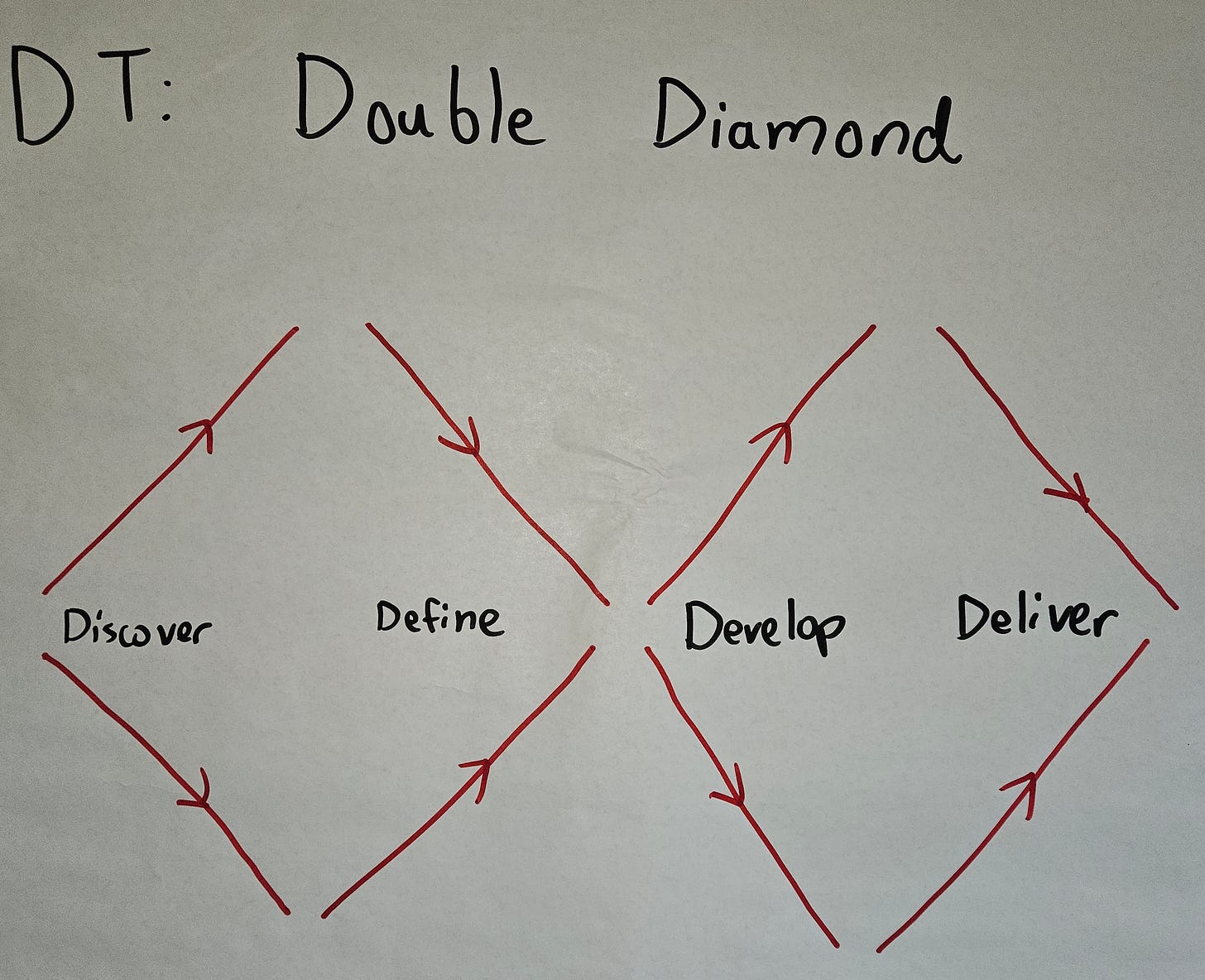Using Design Workshops to advance your data culture
Approach your data culture like a design problem for stronger outcomes
In addition to my recent keynote presentation at UC Berkeley's MIDS Immersion conference, I was also asked to lead an interactive breakout session. I decided to pull forward a skill from my UX days that would bring a new perspective to the Data Science audience: Design Workshops.1
I started with the framing: What happens when we treat our data culture like a design problem? Especially at SaaS and other tech product companies, applying design thinking to what we ship is increasingly common. It can serve to discover innovative solutions that achieve product-market fit. Why not direct those same capabilities internally, to optimize our data culture? What would that look like, and what might we discover about our culture with that approach?
The breakout session ended up being part lecture on Design Thinking and Design Workshops, and part practice. Yes, I crammed a mini Design Workshop into part of a 75-minute breakout session. Yes, having 15 simultaneous small group discussions in a tiny room with poor acoustics proved kinda chaotic. But the feedback on the session surpassed my initial expectations. And that has me convinced, more than ever, at how effective this activity can be at making big, impactful changes to your data culture.
About Design Workshops and Design Thinking
While humans have been designing for millennia, the notion of Design Thinking as a corporate concept is relatively new. In 2008, IDEO president Tim Brown wrote an article for Harvard Business Review that introduced the concept. He encouraged thinking like a designer to innovate in everything you create — whether that's a product, service, process, or strategy.
Design thinking involves taking a human-centered, methodical approach to solving poorly-defined problems. A design thinking process produces innovative solutions to these problems by collaboratively finding the intersection between what people need, what technology enables, and what the business requires.

A great Design Thinking case study comes from Nordstrom Labs in 2013. When the team set out to build an iPad app to support the purchase of sunglasses, they leveraged a number of tools in the Design Thinking toolkit. But they also took it a step further: Centering customer empathy by setting up shop in the middle of Nordstrom's flagship store, to continuously connect with real customers while building.
UX Designers and Researchers learn a wide range of methods and approaches to center customer empathy in their work, some of which were on display in the Nordstrom Labs video. One highly-collaborative example is the Design Workshop. A Design Workshop is so-named because it’s a hands-on, multi-disciplinary approach to exploring and problem and solution space together.
A Design Workshop guides ideation by leading participants through multiple divergence-convergence cycles. For example, if 15 participants each brainstorm 10 challenges related to the problem at hand, we've diverged to create 150 possible challenges to focus on. Then, if participants meet in groups of 3 to discuss and cluster their challenges, and each generate 6 clusters, we've converged to just 30 broader themes. By repeating this process, a Design Workshop can explore the breadth of a space, while also focusing the efforts of a broad, multi-disciplinary group.

To return to Tim Brown's original framing, Design Thinking can be used to innovate anywhere — and that certainly includes corporate culture. So what happens when we tap into these methods for that purpose?
I'm on a mission to improve corporate data culture for data professionals of all stripes, in Data Science, UX Research, Analytics, and beyond. If you’d like to join me, you can help by sharing this newsletter with the data culture drivers in your network.
A little goes a long way: Why the breakout session hit like it did
With some background in place, I gave the breakout session participants a prompt to kick off their brainstorming:
What challenges does your organization face with its current data culture?
I then guided the group through three steps:
Brainstorm responses to the prompt, and write each response on a different sticky note.
Form small groups, and share the outcomes of your brainstorming. Seek common themes across sticky notes to form clusters.
Arbitrarily choose one cluster, and discuss different approaches to address the underlying problem. Storyboard one of those solutions.
Experts at workshop facilitation will quickly see skipped steps in this approach — and that's a fair critique. My hope was to give participants a taste of some common workshop activities to pique their interest. But I was pleasantly surprised how deeply some participants resonated with their conversations and sketches.
Despite having very limited time, and skipping steps.
Despite this being participants' first time in a design workshop activity.
Despite their group members working at different companies.
Because even despite these limitations, the workshop created a space for empathy. Participants could articulate the challenges in their data culture, hear perspectives (similar and different) from others, find common ground, and explore solutions to challenges. Imagine the impact a half-day, or even 2-hour, workshop could have had.
Data professionals aren't usually asked to set aside time for this kind of activity, so when they are, it can be morale boosting in the short term. And, it can give data leaders inspiration for where to focus their data culture efforts longer term.
In a future post, I'll share some tips to get started leading a workshop for your team to innovate on your data culture. But if you're keen to get started now, don't wait! Connect with your Design team to start thinking through how you might build this practice.2 Also, you may already use a tool (e.g., Figjam, Miro) with templates to support these workshops. However you proceed, it's never too early to start making space for empathy to advance your data culture.
*** *** *** *** ***
That's a wrap on 2024 for the Deliberate Data Culture substack. I'll be taking a break for a few weeks for the holidays, and to focus on a strong start to 2025.
A huge thank you to everyone who has supported me in my writing journey this year. It's been so rewarding for me to sort through all the data culture thoughts that have been swirling in my head for so long and put them to "paper," so to speak. Seeing that this content resonates with so many of you just further reinforces that this is time well spent.
More to come in 2025. Until then, best wishes to all for a rejuvenating and fulfilling holiday season.
Former colleagues are likely not surprised by my decision. I've never met a group discussion that wasn't enriched with some workshopifying.
A friendly reminder that Design teams dislike randomization as much as you and your team. Do reach out to discuss how a workshop might help in your organization, but don't ask them to do all the heavy lifting. Data leaders can go far on their own with some minimal feedback and coaching from experts.



